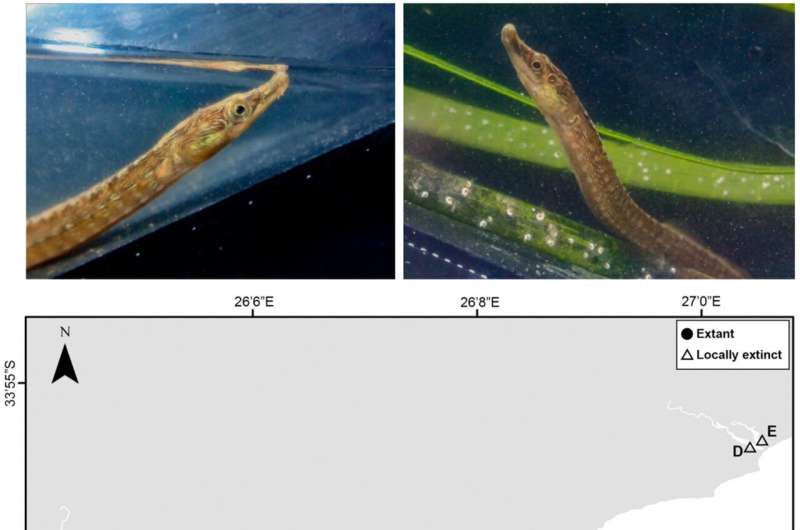(A) Syngnathus watermeyeri photographed (Louw Claassens) in the Bushmans estuary in October 2019. (B) Location of estuaries sampled (n = 5) within the historic range on the Eastern Cape of South Africa (insert). Extant populations (solid circles)—Bushmans (A) and Kariega (B) estuaries, and locally extinct populations (open triangles)—Kasouga (C), West Kleinemonde (D), and East Kleinemonde (E) indicated. Credit: Environmental DNA (2022). DOI: 10.1002/edn3.365
New Curtin University-led research has used eDNA technology to track the movements of a critically endangered fish in South Africa in the hope of safeguarding its future.
The Estuarine pipefish is the only critically endangered species in the Syngnathidae family, with an estimated 100 to 250 remaining globally. The species was originally classified as extinct in 1994 before being rediscovered in 1996 and—to date—there is no species monitoring or recovery plan in place.
Published in Environmental DNA, the research team collected samples from 39 sites in the Eastern Cape of South Africa in 2019 and found that the Estuarine pipefish resided in two estuaries, Kariega and Bushmans, due to their high vegetation cover of eelgrass.
Lead researcher Ph.D. student Georgia Nester, from Curtin's School of Molecular and Life Sciences, said marine ecosystems were facing unprecedented levels of disturbance with rare species often being the most vulnerable, so it was critical to identify the most effective way to monitor and manage their recovery.
"In order to effectively manage rare or threatened species, we need to understand their environment, population size and the threats they face. This can be especially difficult for small species in aquatic environments—the largest Estuarine pipefish recorded was only 15 centimeters in length," Ms. Nester said.
"By using eDNA technology, our team was able to identify locations where the Estuarine pipefish lives and learn more about their preferred habitats, challenges and threats. We were also able to eliminate locations where they were previously found, such as in the Kasouga, East or West Kleinemonde estuaries in South Africa, suggesting that this critically endangered species has been wiped out from these locations due to flooding in the area.
"Our study provides information that will revolutionize current conservation efforts for this species. If we map vegetation in other estuaries in the region, we can identify potential locations to reintroduce this critically endangered species. Our eDNA toolkit can then be used to monitor the success of these reintroductions, and hopefully bring this species back from the brink of extinction."
Ms. Nester said the study provided important insights on the use of eDNA technology and how this non-destructive, non-invasive tool could be beneficial to effectively monitor other rare and critically endangered species.
"Our study used two different techniques—eDNA and seine netting, which uses fishing nets to catch the species—to track the location and movements of the Estuarine pipefish and found that using eDNA was four times more effective compared to seine netting," Ms. Nester said.
"This new information can now help guide a long-term monitoring program to support this critically endangered species and prevent it from becoming extinct."
More information: Georgia M. Nester et al, Characterizing the distribution of the critically endangered estuarine pipefish ( Syngnathus watermeyeri ) across its range using environmental DNA, Environmental DNA (2022). DOI: 10.1002/edn3.365
Provided by Curtin University
























